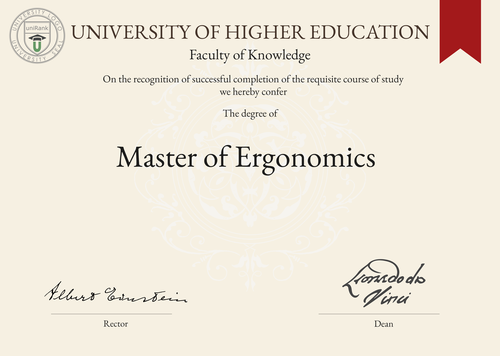
Master of Ergonomics (M.Erg.)
Guide to Master of Ergonomics Program/Course/Degree
Master of Ergonomics (M.Erg.)

Degree Name:
Master of Ergonomics
Degree Abbreviation:
M.Erg.
Duration Range:
1-2 years
Tuition Range (US, UK, AUS, NZ):
$10,000-$50,000
Overview:
A Master of Ergonomics degree is a postgraduate program that focuses on the study of human factors and how they interact with the environment. This degree program is designed to equip students with the knowledge and skills needed to design and develop products, systems and environments that are safe, efficient and comfortable for people to use.
Curriculum Overview by Year:
- Year 1:
- Introduction to Ergonomics
- Human Factors and Design
- Anthropometry and Biomechanics
- Environmental Ergonomics
- Research Methods in Ergonomics
- Year 2:
- Ergonomics in Product Design
- Ergonomics in Workplace Design
- Ergonomics in Health and Safety
- Ergonomics in Transportation Design
- Thesis or Capstone Project
Key Components:
The key components of a Master of Ergonomics degree program include the study of human factors, design, anthropometry, biomechanics and research methods. Students will also learn about ergonomics in product design, workplace design, health and safety and transportation design. The program may also include a thesis or capstone project.
Career Prospects:
Graduates of a Master of Ergonomics degree program can pursue careers in a variety of industries, including product design, manufacturing, healthcare, transportation and government. Job titles may include ergonomist, human factors engineer, product designer, safety engineer and usability specialist.
Salary Expectations:
The salary expectations for graduates of a Master of Ergonomics degree program can vary depending on the industry and job title. According to Payscale, the average salary for an ergonomist is $72,000 per year, while the average salary for a human factors engineer is $85,000 per year.
For a more accurate understanding of salary expectations, you can utilize the Job Sites Search Engine, from our sister site jobRank, which searches over 4,600 job sites worldwide. Make sure to specify not only the job title but also the country you are interested in.Conclusions:
Overall, a Master of Ergonomics degree program is a great choice for students who are interested in the study of human factors and how they interact with the environment. However, it is important to note that degree duration, tuition fees, curriculum, key components, career prospects and salary expectations can vary by the chosen country and university where to study this degree. Visitors can search where this specific degree (Master of Ergonomics) is offered anywhere in the world through the uniRank World Universities Search Engine.
World Universities Search Engine
search for Master of Ergonomics (M.Erg.) and add the Location (country, state etc.) or specific University you are interested in studying at.
Query examples:
- Master of Ergonomics (M.Erg.) United States
- Master of Ergonomics (M.Erg.) United Kingdom online
- Master of Ergonomics (M.Erg.) Australia international students
- Master of Ergonomics (M.Erg.) University of California
- Master of Ergonomics (M.Erg.) University of London tuition fees
- Master of Ergonomics (M.Erg.) University of Sydney scholarships
Share Program/Course
Interesting? Share this program/course/degree info with your friends now.